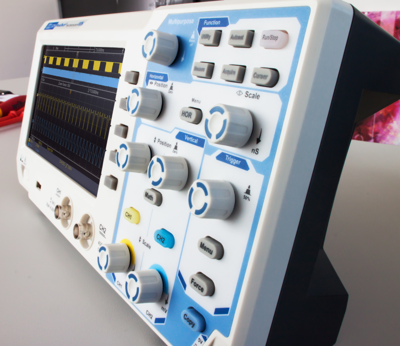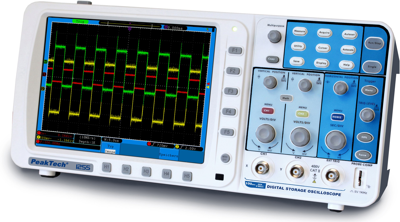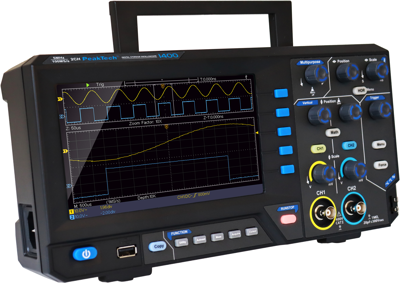
Oscilloscope: Measuring smarter with 12 bit
Efficiency is the buzzword of modern technology and electronics. Characterized by the desire to achieve ever more optimized results with diverse work and production processes, increasingly higher demands are being placed on the resources used. In measurement technology, for example, everything revolves around capturing signals clearly and in detail - and with minimal effort. 12-bit oscilloscopes are regarded as particularly powerful instruments that set new standards.
What is an oscilloscope?
An oscilloscope is an indispensable measuring device in electronics that is used to graphically display the progression of electrical voltages over time. It enables technicians to visualize and analyze electrical signals in order to check the function of electronic circuits and diagnose faults.
What oscilloscopes are available?
In principle, both analog and digital oscilloscopes with built-in A/D converters (analog-to-digital converters) are available on the market. However, the latter dominate – for example because of the possibility of saving measurement results.
However, the unsurpassed accuracy achieved with digital instruments is particularly impressive. For example, analog oscilloscopes have a horizontal accuracy of +/- 3 %, while the digital version has an average accuracy of +/- 0.01 %.
The models are constantly being further developed in order to meet the increasing requirements and to ensure the lowest possible noise representation of the signal with a high sampling rate. As a result, modern oscilloscopes nowadays often have a horizontal accuracy of +/- 0.0005 % or better.
What does bit stand for?
The color depth or, in this context, the resolution of an oscilloscope is specified in bits. Two color gradations can be displayed per bit, which means that 16 gradations are possible with a resolution of 4 bits and 256 gradations with 8 bits. At 12 bits, the number increases to 4,096 gradations, which enables a significant improvement in measurement accuracy.
Trend development: from 8-bit to 12-bit oscilloscopes
For a long time, 8-bit oscilloscopes were considered the proven standard for signal measurement – so where does the hype surrounding the increasingly popular 12-bit version come from? While 8-bit oscilloscopes offer 256 different signal intensity levels, this number increases to an impressive 4,096 levels when using 12-bit oscilloscopes.
8-bit oscilloscopes attempt to improve their limited ability to capture detail by averaging multiple measurements. This process can therefore somewhat refine the representation of the signal, but the result does not achieve the precision of true 12-bit oscilloscopes. These can capture finer details and smaller differences in signals directly, without relying on averaging techniques. The result: more precise and more reliable measurement. Ideal for applications where the detection of subtle signal variations is critical.
Advantages of 12-bit oscilloscopes at a glance
In short: oscilloscopes with 12-bit resolution measure more accurately. The increased level of detail makes it possible to display the measurement result more precisely, which means that the signals can be read and interpreted better. Specifically, this results in the following significant advantages:
- Higher resolution: Compared to standard 8-bit oscilloscopes, 12-bit models offer 16 times higher resolution. This enables a more accurate representation of signals, especially in areas where subtle differences are critical.
- Improved DC accuracy: With an accuracy of +/- 0.5 % compared to +/- 2 % for 8-bit devices, which corresponds to an effective improvement of 2.5 bits, they significantly optimize the signals both on the time level and in terms of frequency.
- Better signal representation: With 12 bits, finer details and slight variations in signals can be captured, which is crucial for fault diagnosis and signal analysis. Even unwanted jitter (unrhythmic “trembling” in signal transmission) can be recorded and analyzed.
- Reduced noise: The higher bit rate results in more effective noise reduction, allowing signals to be displayed more clearly and accurately.
- Improved dynamic range: 12-bit oscilloscopes offer a wider dynamic range, making it possible to measure both very small and large signal amplitudes without loss of detail.
- Finer measurements: Thanks to the higher resolution, users can make more precise measurements without averaging afterwards or using the high-resolution mode.
- Increased accuracy along the horizontal axis: Parameters measured horizontally, such as frequency, pulse width, delay or even delay differences, can be viewed more concretely, leading to sharper results.
Application examples of 12-bit oscilloscopes
In electronic and electrical measurement technology, 12-bit oscilloscopes play a crucial role in precise analysis and diagnosis.
High-performance circuits
When designing circuits in microelectronics, 12-bit oscilloscopes can detect the smallest voltage deviations, which can be critical in the miniaturization of components.
Signal quality in telecommunications
12-bit oscilloscopes enable detailed signal analysis to detect interference and distortion. They make an important contribution to ensuring the integrity of data transmission, which is essential for high quality voice, video and data communication.
Automotive industry
12-bit oscilloscopes are used for troubleshooting and performance testing in complex electronic control systems. For example, they help to check the precise functioning of electronic control systems, such as brake assistance systems, by detecting minimal signal fluctuations.
Power supply
When monitoring and analyzing the power grid, the high resolution is useful for identifying unwanted signal interference that can affect the power quality. This is particularly important in highly automated production environments, where even small faults can lead to major failures.
Research laboratories
12-bit oscilloscopes enable researchers to gain insights into electrical phenomena at the atomic level. These insights are essential for advances in nanotechnology and materials science
Your new oscilloscope – found at Bürklin Elektronik
Do you still need the right instruments for perfect measurement? Bürklin Elektronik’s online store has a large selection. Between oscilloscopes, multimeters, voltage testers and many other electrical and electronic devices from well-known manufacturers, you can quickly navigate to the product you need. The experienced Bürklin Elektronik team is always available to provide you with expert advice.






